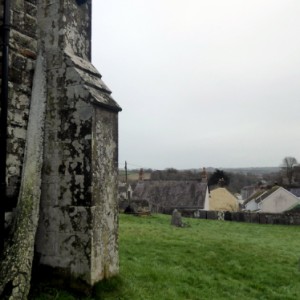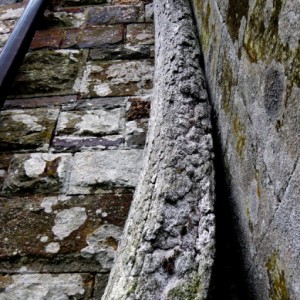Surprise at St Dog's
Having admired the ancient yew tree outside St Dogmael's church - 500 years old if it's a day and fastened into its containing wall with sturdy iron bands - I looked left and saw something really exciting.
Propped against the church wall as casually as if it were an old curved plank from a clinker-built boat was something I recognised instantly as a whale bone. I couldn't believe it was just leaning there unprotected and unremarked. (Extras)
Whale bones were brought home as trophies by mariners - and St Dog's was a mariners' community where most of the men were engaged in local fishing or in ocean going trade..
I've now discovered that three whale jawbones were brought back to Cardigan by a local sea captain in 1871. Two were given to Cardigan castle to form an arch (which has in recent years been rescued and restored*) and the other was given to the vicar of St Dogmael's. It resided in the vicarage garden for many years but was thrown out when the place was sold (predictably it's now a posh B&B). So it seems the bone come to rest against the church as casually as if it were an old mop. It deserves better!!
It needs to be rescued and I shall do my best to make it happen.
" Once there were hundreds [of whale bone arches], but most have vanished through decay and neglect. Erecting these arches has been a custom since at least the 1600s, reaching its peak as the Arctic whaling trade flourished 1750-1830, when it became fashionable to set up the heavy bones over gateways. Many jawbones were sawn in half to make gateposts. Other bones have come from stranded whales.The majority of jaw bone arches are to be found on the east side of the country near the main whaling ports such as Dundee, Whitby and Hull."
The above was written by Nicholas Redman, the only person to have recorded and described all the whale bones that remain in Britain. They are dwindling in number - and some might say that is the best fate for these souvenirs of a cruel and ruthless industry, but they are also reminders of a way of life that sustained, and destroyed, many lives - men who had little choice in the way they earned their livelihood. The churchyard graves bear witness to many mariners who perished on the high seas or in distant ports.
[This type of whalebone was not what was used for corsets and many other items before the invention of plastic. That was baleen, the flexible material that served to strain out of seawater the tiny organisms that constituted the food of some whale species.]
*Described here



Comments
Sign in or get an account to comment.


